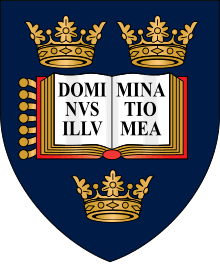Pembroke College, Oxford
| Pembroke College | ||||||||||||
|---|---|---|---|---|---|---|---|---|---|---|---|---|
| Oxford | ||||||||||||
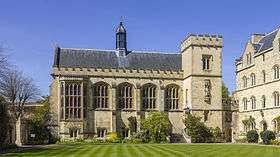 | ||||||||||||
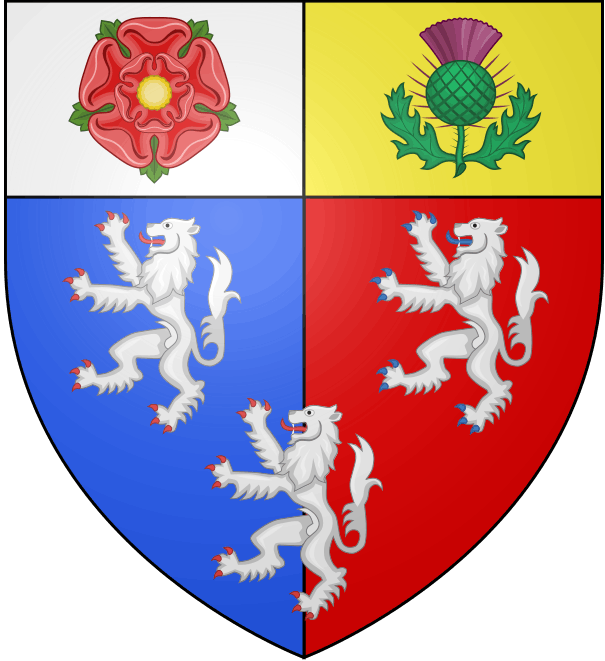 Blazon: see below | ||||||||||||
|
| ||||||||||||
| Location | Pembroke Square, Oxford | |||||||||||
| Coordinates | 51°45′00″N 1°15′28″W / 51.750062°N 1.257827°WCoordinates: 51°45′00″N 1°15′28″W / 51.750062°N 1.257827°W | |||||||||||
| Full name | The Master, Fellows, and Scholars of Pembroke College | |||||||||||
| Latin name | Collegium Pembrochianum | |||||||||||
| Established | 1624 | |||||||||||
| Named for | William Herbert, 3rd Earl of Pembroke | |||||||||||
| Sister college | Queens' College, Cambridge | |||||||||||
| Master | Dame Lynne Brindley | |||||||||||
| Undergraduates | 365[1] (2015/2016) | |||||||||||
| Postgraduates | 227 | |||||||||||
| Website |
www | |||||||||||
| Boat club | Boat club | |||||||||||
| Map | ||||||||||||
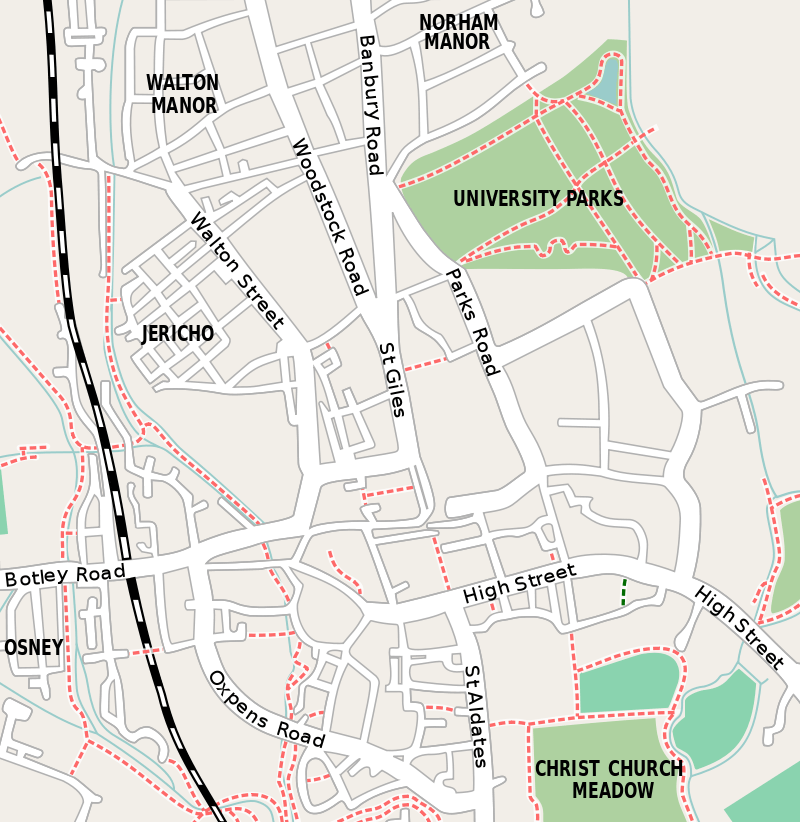 Location in Oxford city centre | ||||||||||||
Pembroke College is one of the constituent colleges of the University of Oxford in England, located in Pembroke Square. The college was founded in 1624 by King James I of England / VI of Scotland, using in part the endowment of merchant Thomas Tesdale, and was named after William Herbert, 3rd Earl of Pembroke, Lord Chamberlain and then-Chancellor of the University.[2]
Like many of Oxford's colleges, Pembroke admitted its first mixed-sex cohort in 1979, having previously accepted men only.[2] As of 2017, Pembroke had an estimated financial endowment of £54.9 million.[3] Pembroke offers the study of almost all the courses offered by the university.
Dame Lynne Brindley, former head of the British Library, has been Master of the College since 2013.
History
In the early seventeenth century, the endowment of Thomas Tesdale—a merchant from nearby Abingdon – and Rev. Richard Wightwick, the parish priest of Donnington, Shropshire – enabled the conversion of Broadgates Hall, which had been a University hostel for law students since its construction in the fifteenth century, to form the basis of a fully-fledged college. The letters patent to found the college were signed by King James I in 1624, with the college being named after William Herbert, 3rd Earl of Pembroke, Lord Chamberlain, Chancellor of the University,[2] and rumoured patron of William Shakespeare.
Buildings

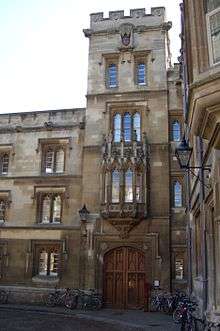
Following its foundation, the college proceeded to expand around Broadgates, building what is now known as "Old Quad" in the 1600s. Built in stages through the seventeenth century out of the local Cotswold limestone, space restrictions saw the south-side of the Quad built directly on top of the old City Wall. A Chapel was built in 1732, and the introduction of further accommodation in 1846, and the Hall in 1848 to designs by Exeter-based architect John Hayward[4] created "Chapel Quad"—widely considered one of the most beautiful Quads in the University.[5] The Chapel was designed and built by William Townsend, although the interior was dramatically redesigned by Charles Kempe—a Pembroke graduate—in 1884. Pembroke alumnus Dr. Damon Wells is a significant benefactor of the College over many years; he enabled the restoration of the Chapel in 1972, and continues to support the Chaplaincy and History Fellowship. The Chapel which is still used for regular worship bears his name.[6]
Modern expansion

Further expansion of the college came in the 1960s, after the closure of Beef Lane to the north of Chapel Quad. The private houses north of the closed road were acquired by the College in a piecemeal fashion and reversed so that access was only possible from the rear. The new area is now known as "North Quad", which was formally opened in 1962.[5] A modern annex, built near to college on the banks of the Isis at Grandpont, provides accommodation for thirty six graduates and around forty undergraduates. Named the Geoffrey Arthur Building (commonly referred to as "The GAB"), the building was named for the diplomat Sir Geoffrey Arthur — a former master of the college (1975–1985).[7]
In April 2013 the Duke of Kent officially opened two new quadrangles, with new buildings including a 170-seat multi-purpose auditorium, a new cafe, art gallery, and teaching and function rooms. The development is physically joined to the College's existing city-centre site via a new bridge crossing Brewer Street and the original medieval city wall, and 'landing' in the old fellows' garden adjacent to Chapel Quad. Having historically been one of the university's physically smaller colleges, following the opening of the new building, undergraduates are now able to live in college premises for all years of study; postgraduates benefit from more rooms, and six flats for those with partners.[8]
Coat of arms
The arms of Pembroke College were granted by the College of Heralds on 14 February 1625, the formal blazon describing it as:
- “Per pale azure and gules three Lyons rampant, two and one, Argent, in a Cheife party per pale Argent and Or, in the first a Rose Gules, seeded or, barbed vert in second a Thistle of Scotland proper”.
Both James I, as founder of the college, and the Earl of Pembroke are commemorated in the arms. The former, representing the union of the crowns as James I of England and James VI of Scotland, is symbolised by the rose (of England) and the thistle (of Scotland). The three lions rampant are taken from the Earl’s personal coat arms.
Admissions
Pembroke offers a broad range of courses, covering almost all the subject areas offered by the university; Literae Humaniores (Classics), Geography and Computer Science are notable exceptions. In particular, the college has had a strong involvement with Economics, as well as Management Studies, being the first traditional Oxford College to appoint a Fellow in the field.[9] The college has maintained a close relationship with the Saïd Business School.
In March 2002 two Oxford fellows resigned after allegations that they had offered a place to the fictional child of an undercover reporter in return for a donation to the college library. The journalist alleged that he had taped a conversation where he posed as the father of a fictitious son.[10]
Pembroke runs its own access schemes entitled 'Pem-Brooke' and 'Pembroke North' which work with disadvantaged students from London and areas of the North. These schemes provide students with long-term academically intensive programmes, which will give students important skills that will support them with both Oxbridge applications but also Russell Group university applications. This type of approach is seen as atypical within widening participation work in Oxford.[11]
Student life
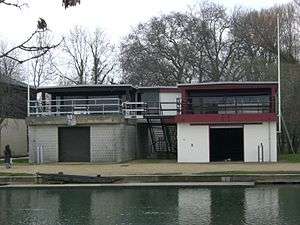
Junior and Middle Common Rooms
Pembroke is home to a Junior Common Room (undergraduate community) notable for its artistic wealth and sporting prowess. The JCR is the wealthiest in Oxford due to the purchase and sale of a Francis Bacon painting in the early 20th century; it was bought in 1953 for £150 and sold for £400,000 in 1997.[12] The JCR has used those funds to support a socially progressive student support scheme and an impressive artistic acquisition programme.
The Middle Common Room, for postgraduates, is housed in a suite of historic mahogany-panelled rooms and is noted for its connections with a wide range of nations. Its current patron is Lord Kerr, former Permanent Secretary at the Foreign and Commonwealth Office, British Representative to the European Union and Ambassador to the United States.
Sport
The college has a strong sporting reputation across the university. Recent years have seen the JCR achieve particular success at rugby, cricket, football, hockey and darts. In 2018, Pembroke made history by becoming the first college to win two rugby honours in one year, with the women's team winning Cuppers, and the men's team winning the Cuppers Bowl. 2018 also saw Pembroke win Cuppers in mixed netball and futsal. The MCR has been particularly strong at women's boxing, polo and cricket. Despite being a newly formed team, Pembroke has also done well in pool, reaching the semifinals in the 2015 Pool Cuppers.
Pembroke College Boat Club is one of Oxford's strongest boat clubs, in 2013 holding both the Torpids and Summer Eights men's headship, with the women's 1st boat sitting at 4th and 7th places respectively. In 2016, the men held Head of the River in Torpids and 4th in Summer Eights, and the women held 3rd and 2nd for Torpids and Summer Eights respectively. Pembroke Men's 2nd Torpids also bumped five places up to 11th in Division 1 - the first time there have been two men's boats from a single college in over 40 years. Pembroke has been the top club in aggregate points across all boats for three years running.[13] In 2003, Pembroke became the first college ever to win the "Double Headship Trophy" for having both men's and women's Eights head the river. In 2018, the Pembroke Women's 1st boat again achieved the Summer Eights headship.
People associated with Pembroke
Notable people
 Abdullah II of Jordan, King of Jordan, studied Middle Eastern Affairs in 1982.
Abdullah II of Jordan, King of Jordan, studied Middle Eastern Affairs in 1982.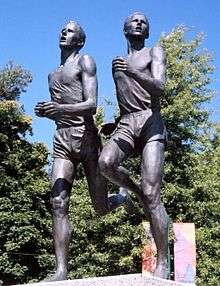 Sir Roger Bannister, neurologist and former Master of Pembroke College; first man to run a sub four-minute mile
Sir Roger Bannister, neurologist and former Master of Pembroke College; first man to run a sub four-minute mile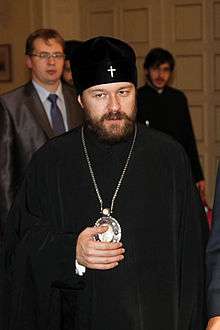 Hilarion Alfayev, Bishop of Russian Orthodox Church, took his DPhil in Theology in the early 1990s.
Hilarion Alfayev, Bishop of Russian Orthodox Church, took his DPhil in Theology in the early 1990s. J. William Fulbright, senior U.S. Senator, founder of the Fulbright Scholarships
J. William Fulbright, senior U.S. Senator, founder of the Fulbright Scholarships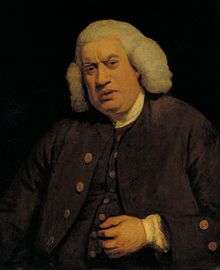 Samuel Johnson, essayist, moralist, literary critic and author of first English dictionary
Samuel Johnson, essayist, moralist, literary critic and author of first English dictionary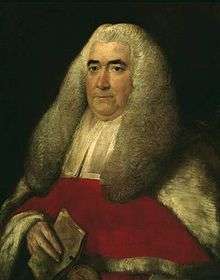 Sir William Blackstone, English jurist and legal scholar, famed for his Commentaries on the Laws of England
Sir William Blackstone, English jurist and legal scholar, famed for his Commentaries on the Laws of England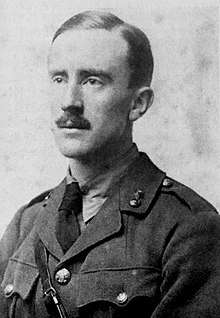 J. R. R. Tolkien,
J. R. R. Tolkien,
Professor of Anglo-Saxon at Pembroke. Authored The Lord of the Rings during his time there_(10559130986).jpg) Michael Heseltine, former British Deputy Prime Minister
Michael Heseltine, former British Deputy Prime Minister- Walter Isaacson, President & CEO of Aspen Institute, biographer
 Viktor Orbán, Prime Minister of Hungary
Viktor Orbán, Prime Minister of Hungary.jpg) George Whitfield, founder of evangelical Methodism, enormously popular preacher in 18th century America
George Whitfield, founder of evangelical Methodism, enormously popular preacher in 18th century America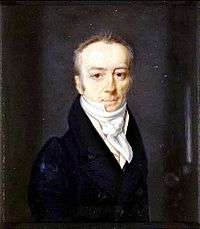 James Smithson, English chemist, founder of the Smithsonian Institution
James Smithson, English chemist, founder of the Smithsonian Institution Sir Peter Ricketts, former Chairman of Joint Intelligence Committee, currently British Ambassador to France
Sir Peter Ricketts, former Chairman of Joint Intelligence Committee, currently British Ambassador to France

Samuel Johnson was one of the College's more famous alumni, though he did not complete his degree (he was later awarded an honorary degree by the University); lack of funds forced him to leave Oxford after about a year and a half. Two of his desks and various other possessions are displayed around the college. He spoke fondly of Pembroke to his death, recalling especially the college's many poets, telling friends that ‘we were a nest of singing birds.'[14] James Smithson, whose bequest founded the Smithsonian Institution in Washington, D.C. (despite him never having visited the United States) was an undergraduate at Pembroke, under the name "James Lewis Macie"—he changed his name to that of his natural father after the death of his mother. Meanwhile, Senator J. William Fulbright, who established the Fulbright Program, was a Rhodes Scholar at Pembroke in the 1920s.
Diplomacy
Thomas Randolph, Principal of Pembroke's precursor mediaeval hall, Broadgates, served as ambassador for Elizabeth I in Scotland from 1559, where he acquired the friendship of Mary, Queen of Scots, until he was accused of supporting the rebellion of James Stuart.[15] In 1568 he was sent to Russia to secure trading rights from Ivan IV, better known as Ivan the terrible, and succeeded in winning valuable access to Russia for English merchants.
More recently, John Kerr, Baron Kerr of Kinlochard, served as UK Ambassador to the United States from 1995 to 1997, before being appointed Head of the British Foreign and Commonwealth Office. Philip Lader served as US Ambassador to the UK from 1997 to 2001. Thus in 1997, both the US Ambassador in London and the UK Ambassador in Washington were former Pembroke students. Sir Peter Ricketts also served as head of the Foreign and Commonwealth Office from 2006 until 2010, and was then British Ambassador to France for six years until his retirement in 2016.
Additionally, two former chairs of the Senate Foreign Relations Committee Senator Richard G. Lugar, (Republican), and Senator J. William Fulbright (Democrat), were students of Pembroke, between them chairing the Senate Foreign Relations Committee for a 27-year period.[16]
Beyond the transatlantic, the Foreign Minister of Poland, Radek Sikorski, the Prime Minister of Hungary, Viktor Orbán, and King Abdullah II of Jordan all studied at Pembroke.
Fellows
J. R. R. Tolkien was a Fellow of Pembroke from 1925 to 1945, and wrote The Hobbit and the first two volumes of The Lord of the Rings during his time there. Since 2013 the college has held an annual lecture on fantasy literature in his honour.[17] Robin G. Collingwood, historian, philosopher, and author of The Idea of History, was a fellow of the college between the Great War and the Second World War.
Masters
Among the College's more recent Masters were Sir Geoffrey Arthur, former chair of the Joint Intelligence Committee and Roger Bannister, the first man to run the mile in under four minutes. Dame Lynne Brindley, the former Chief Executive of the British Library (July 2000 until July 2012), the United Kingdom's national library, was elected to succeed Giles Henderson as the Master of Pembroke College, and began her tenure on August 1, 2013.[18]
References
- ↑ "Graduate and Undergraduate Admission Statistics". University of Oxford.
- 1 2 3 "History". www.pmb.ox.ac.uk. Retrieved 10 October 2018.
- ↑ "Annual Report and Financial Statements". www.pmb.ox.ac.uk. Retrieved 10 October 2018.
- ↑ Oxford: an architectural guide, Geoffrey Tyack. ISBN 0-19-817423-3, ISBN 978-0-19-817423-3
- 1 2 "Buildings - Pembroke College, University of Oxford". Archived from the original on 2008-05-01. Retrieved 2007-11-10.
- ↑ "Chapel History - Pembroke College, University of Oxford". Archived from the original on 2008-05-15. Retrieved 2007-11-10.
- ↑ "Geoffrey Arthur Building - Pembroke College, Oxford". Archived from the original on 2008-05-24. Retrieved 2007-11-10.
- ↑
- ↑ "Pembroke College Course Guide: Economics & Management". Archived from the original on 2013-10-22.
- ↑ Graves, David (2002-03-25). "2002 Admissions Scandal". The Daily Telegraph. London. Retrieved 2010-05-22.
- ↑ "Access Programme 2012-2016" (PDF). Pembroke College. Oxford. Retrieved 2017-01-20.
- ↑ "Pembroke College JCR Art: A Bit of History".
- ↑ See http://www.atm.ox.ac.uk/rowing/points/%5Bpermanent+dead+link%5D for points tables.
- ↑ https://www.gutenberg.org/files/42960/42960-h/42960-h.htm
- ↑ "Thomas Randolph (poet) Facts, information, pictures | Encyclopedia.com articles about Thomas Randolph (poet)". Encyclopedia.com. Retrieved 2013-04-27.
- ↑ The next American century: essays in honor of Richard G. Lugar - Google Books. Books.google.com.au. Retrieved 2013-04-27.
- ↑ Tolkien Lecture Series, Pembroke College, Oxford. Retrieved 2017-06-20.
- ↑ Pembroke College - Next Master Elected Archived 2013-03-23 at the Wayback Machine.
External links
| Wikimedia Commons has media related to Pembroke College, Oxford. |
